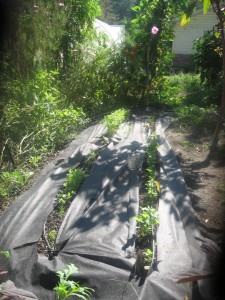A seasonal stereotype festers every time fall begins its crisp dance of falling leaves. Summer persuades most minds that it is the only season for growing. It’s hard not to blame anyone for the thought. A feast of red ripe tomatoes, glistening cukes, and the age old implementation of the three sisters adorn the summer plot.
However, once the wind alerts the nose that humidity must exit, most growers pack it up until next spring.The other problem that attaches is that alot of fall seeds must be sown in late July and August when the heat is still ugly.
It’s a shame because fall gardens can be some of the most rewarding growing of any season. For starters, the oppressive heat is gone, creating a love for outside activity beyond watering. Second, the taste of fall–peppery arugula, earthy beets, sugar tinged carrots–step side by side with the comfort that fall brings.
If you do plan on starting a fall garden for the first time, go to our resources page for fall planting info. It’s late for most seeding (sans onions), but luckily, there are enough nurseries in the area with ready to go starts.
Another thing to remember is that although the hot weather has humbled, the pests are still buzzing. A good guard if you’re pesticide wary is any kind of pest blanket cover like N-Dure. It’s light, it allows 85% light penetration, and it’s been effective against the onslaught of flea beetles. Other barriers likeSluggo for snails and slugs, and Diatomaceous Earth for the hard-bodied bugs should keep most problems at bay. Pyrethrinsare natural (an organic compound that is contained in the seed cases of an African Chrysanthemum), but should be used as a last resort due to its harm of beneficials.

Fertilizers and amendments should be heavy on the root side of things since alot of fall favorites derive its tastiness from that region. A good dose of mycorrhizae can either be incoporated with a granular when garden bed prepping, or as a water soluble additive during plant growth. Other root tonics are any seaweed concentrates (like Maxicrop) , kelp meals, and humic acids.

Also, a good overall fertilizer that owns high phosphorous numbers (the middle # in the fertilizer reading, i.e 5-5-5) will benefit fall plants. If you really want to lay the phosphorous down, go with soft rock phosphate or Tennessee rock phosphate and incorporate (through tilling or the back bending double dig) into the beds. Ashevillian Jim Smith, of Good Earth Organics, recommends going with soft rock phosphate since beneficial microbes readily attach to it.

Leave a Reply